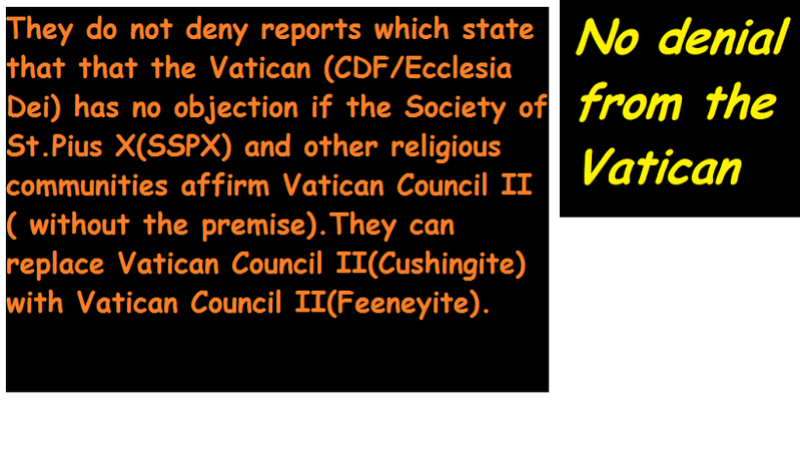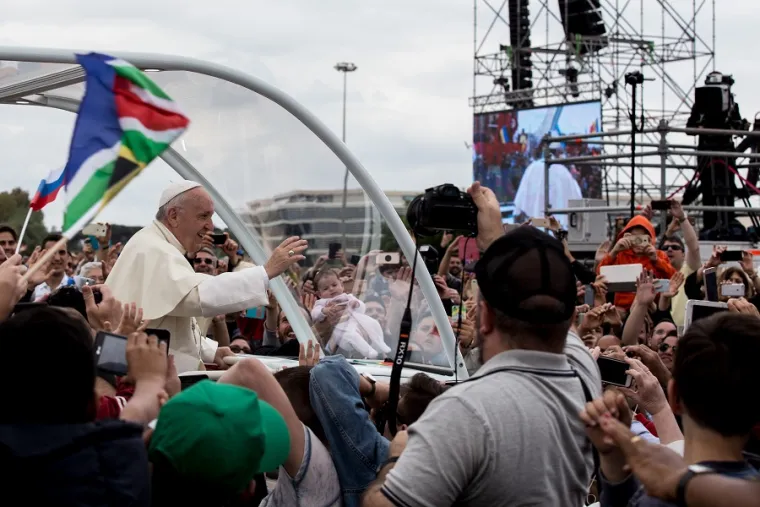When I say that there is no magisterial document which contradicts the strict interpretation of the dogma extra ecclesiam nulla salus (EENS) many will be surprised. Since off hand they could think of Lumen Gentium 16 ( invincible ignorance) or Lumen Gentium 8 ( elements of sanctification and truth in other religions).
In their mind they picture personally known non Catholics saved outside the Catholic Church in ignorance of the Gospel .
But this is a false image.
Since if a person is saved he is known only to God.
On earth we cannot see someone saved in Heaven.
Since we cannot physically see or personally know or meet someone saved outside the Church, there are no objective exceptions for us, to the dogma extra ecclesiam nulla salus (EENS).
A speculative case cannot be an actual exception in 2019.
Someone whom we think is a possibility for salvation is not a real person known to us, who is saved.We cannot guess how Jesus will judge a particular person.
These are all hypothetical cases for us human beings and I have marked them in red in Vatican Council II, Catechism of the Catholic Church, Dominus Iesus and other magisterial documents.
Then the orthodox passages which support exclusive salvation in the Catholic Church and the old ecclesiology, I have marked in blue.
So we can see a pattern. The red passages are all hypothetical.
LG 8, LG 14, UR 3, NA 2, GS 22 etc have all red passages.People wrongly picture them as exceptions to EENS.
They really do not contradict the blue passage in Ad Gentes 7 which says all need faith and baptism for salvation.Neither do they contradict the Catechism of Pope Pius X which says all need to be members of the Church for salvation.Nor they do contradict the dogma EENS defined by three Church Councils.
So when all magisterial documents, with the red passages, which Catholics assume are exceptions to EENS, do not contradict the blue passages and EENS we are back to the old ecclesiology.
There are no exceptions in magisterial documents to the past exclusive ecclesiology.
There are no exceptions in magisterial documents to the old ecumenism of return. Vatican Council II supports only an ecumenism of return in Unitatitis Redintigratio 3.Since the red hypothetical case of someone saved in imperfect communion with the Church is not an exception to the blue passages in UR 3.
Similarly there are no exceptions in magisterial documents to the Syllabus of Errors when it is understood that the red passages are not an exception to the blue.
So Vatican Council II and other magisterial documents do not contradict Tradition, as most people wrongly believe.
-Lionel Andrades







Ad Gentes 7, Vatican Council II
14. This Sacred Council wishes to turn its attention firstly to the Catholic faithful. Basing itself upon Sacred Scripture and Tradition, it teaches that the Church, now sojourning on earth as an exile, is necessary for salvation. Christ, present to us in His Body, which is the Church, is the one Mediator and the unique way of salvation. In explicit terms He Himself affirmed the necessity of faith and baptism(124) and thereby affirmed also the necessity of the Church, for through baptism as through a door men enter the Church. Whosoever, therefore, knowing that the Catholic Church was made necessary by Christ, would refuse to enter or to remain in it, could not be saved.
They are fully incorporated in the society of the Church who, possessing the Spirit of Christ accept her entire system and all the means of salvation given to her, and are united with her as part of her visible bodily structure and through her with Christ, who rules her through the Supreme Pontiff and the bishops. The bonds which bind men to the Church in a visible way are profession of faith, the sacraments, and ecclesiastical government and communion. He is not saved, however, who, though part of the body of the Church, does not persevere in charity. He remains indeed in the bosom of the Church, but, as it were, only in a "bodily" manner and not "in his heart."(12*) All the Church's children should remember that their exalted status is to be attributed not to their own merits but to the special grace of Christ. If they fail moreover to respond to that grace in thought, word and deed, not only shall they not be saved but they will be the more severely judged.(13*)
Catechumens who, moved by the Holy Spirit, seek with explicit intention to be incorporated into the Church are by that very intention joined with her. With love and solicitude Mother Church already embraces them as her own.- Lumen Gentium 14, Vatican Council II
Catechism of the Catholic Church 846-848
"Outside the Church there is no salvation" 846 How are we to understand this affirmation, often repeated by the Church Fathers? Re-formulated positively, it means that all salvation comes from Christ the Head through the Church which is his Body:
DOMINUS IESUS
________________________________
Therefore, no one will be saved who, knowing the Church to have been divinely established by Christ, nevertheless refuses to submit to the Church or withholds obedience from the Roman Pontiff, the Vicar of Christ on earth.
Not only did the Savior command that all nations should enter the Church, but He also decreed the Church to be a means of salvation without which no one can enter the kingdom of eternal glory.
In His infinite mercy God has willed that the effects,necessary for one to be saved, of those helps to salvation which are directed toward man's final end, not by intrinsic
necessity, but only by divine institution, can also be obtained in certain circumstances when those helps are used only in desire and longing. This we see clearly stated in the Sacred Council of Trent, both in reference to the sacrament of regeneration and in reference to the sacrament of penance (, nn. 797, 807).
__________________________
Graphics ( Red does not contradict the blue) (15)







THE RED IS NOT AN EXCEPTION TO THE BLUE
The red passages are an exception to the blue passages for Cardinal Kasper but not for me. What will be his reaction when Cardinals Burke and Brandmuller and Monsignors Ganswein and Bux also say that the red is not an exception to theblue ? So there are no exceptions in magisterial documents to the strict interpretation of the dogma outside the Church there is no salvation, an ecumenism of return and an ecclesiology which supports exclusive salvation in the Catholic Church. No magisterial document contradicts traditional extra ecclesiam nulla salus.
Ad Gentes 7, Vatican Council II
Therefore, all must be converted to Him, made known by the Church's preaching, and all must be incorporated into Him by baptism and into the Church which is His body. For Christ Himself "by stressing in express language the necessity of faith and baptism (cf. Mark 16:16; John 3:5), at the same time confirmed the necessity of the Church, into which men enter by baptism, as by a door. Therefore those men cannot be saved, who though aware that God, through Jesus Christ founded the Church as something necessary, still do not wish to enter into it, or to persevere in it." Therefore though God in ways known to Himself can lead those inculpably ignorant of the Gospel to find that faith without which it is impossible to please Him...- Ad Gentes 7. Vatican Council II
Lumen Gentium 14, Vatican Council II
14. This Sacred Council wishes to turn its attention firstly to the Catholic faithful. Basing itself upon Sacred Scripture and Tradition, it teaches that the Church, now sojourning on earth as an exile, is necessary for salvation. Christ, present to us in His Body, which is the Church, is the one Mediator and the unique way of salvation. In explicit terms He Himself affirmed the necessity of faith and baptism(124) and thereby affirmed also the necessity of the Church, for through baptism as through a door men enter the Church. Whosoever, therefore, knowing that the Catholic Church was made necessary by Christ, would refuse to enter or to remain in it, could not be saved.
They are fully incorporated in the society of the Church who, possessing the Spirit of Christ accept her entire system and all the means of salvation given to her, and are united with her as part of her visible bodily structure and through her with Christ, who rules her through the Supreme Pontiff and the bishops. The bonds which bind men to the Church in a visible way are profession of faith, the sacraments, and ecclesiastical government and communion. He is not saved, however, who, though part of the body of the Church, does not persevere in charity. He remains indeed in the bosom of the Church, but, as it were, only in a "bodily" manner and not "in his heart."(12*) All the Church's children should remember that their exalted status is to be attributed not to their own merits but to the special grace of Christ. If they fail moreover to respond to that grace in thought, word and deed, not only shall they not be saved but they will be the more severely judged.(13*)
Catechumens who, moved by the Holy Spirit, seek with explicit intention to be incorporated into the Church are by that very intention joined with her. With love and solicitude Mother Church already embraces them as her own.- Lumen Gentium 14, Vatican Council II
Unitatis Redintigratio (Decree on Ecumenism), Vatican Council II
It follows that the separated Churches(23) and Communities as such, though we believe them to be deficient in some respects, have been by no means deprived of significance and importance in the mystery of salvation. For the Spirit of Christ has not refrained from using them as means of salvation which derive their efficacy from the very fullness of grace and truth entrusted to the Church.
Nevertheless, our separated brethren, whether considered as individuals or as Communities and Churches, are not blessed with that unity which Jesus Christ wished to bestow on all those who through Him were born again into one body, and with Him quickened to newness of life - that unity which the Holy Scriptures and the ancient Tradition of the Church proclaim. For it is only through Christ's Catholic Church, which is "the all-embracing means of salvation," that they can benefit fully from the means of salvation. We believe that Our Lord entrusted all the blessings of the New Covenant to the apostolic college alone, of which Peter is the head, in order to establish the one Body of Christ on earth to which all should be fully incorporated who belong in any way to the people of God. This people of God, though still in its members liable to sin, is ever growing in Christ during its pilgrimage on earth, and is guided by God's gentle wisdom, according to His hidden designs, until it shall happily arrive at the fullness of eternal glory in the heavenly Jerusalem.-Unitatis Redintigratio (Decree on Ecumenism), Vatican Council II
Catechism of the Catholic Church 846-848
"Outside the Church there is no salvation" 846 How are we to understand this affirmation, often repeated by the Church Fathers? Re-formulated positively, it means that all salvation comes from Christ the Head through the Church which is his Body:
- Basing itself on Scripture and Tradition, the Council teaches that the Church, a pilgrim now on earth, is necessary for salvation: the one Christ is the mediator and the way of salvation; he is present to us in his body which is the Church. He himself explicitly asserted the necessity of faith and Baptism, and thereby affirmed at the same time the necessity of the Church which men enter through Baptism as through a door. Hence they could not be saved who, knowing that the Catholic Church was founded as necessary by God through Christ, would refuse either to enter it or to remain in it.
847 This affirmation is not aimed at those who, through no fault of their own, do not know Christ and his Church:
- Those who, through no fault of their own, do not know the Gospel of Christ or his Church, but who nevertheless seek God with a sincere heart, and, moved by grace, try in their actions to do his will as they know it through the dictates of their conscience - those too may achieve eternal salvation.
848 "Although in ways known to himself God can lead those who, through no fault of their own, are ignorant of the Gospel, to that faith without which it is impossible to please him, the Church still has the obligation and also the sacred right to evangelize all men."
-Catechism of the Catholic Church 846-848
-Catechism of the Catholic Church 846-848
DOMINUS IESUS
IV. UNICITY AND UNITY OF THE CHURCH
16. The Lord Jesus, the only Saviour, did not only establish a simple community of disciples, but constituted the Church as a salvific mystery: he himself is in the Church and the Church is in him (cf. Jn 15:1ff.; Gal 3:28; Eph 4:15-16; Acts 9:5). Therefore, the fullness of Christ's salvific mystery belongs also to the Church, inseparably united to her Lord. Indeed, Jesus Christ continues his presence and his work of salvation in the Church and by means of the Church (cf. Col 1:24-27),47 which is his body (cf. 1 Cor 12:12-13, 27; Col 1:18).48 And thus, just as the head and members of a living body, though not identical, are inseparable, so too Christ and the Church can neither be confused nor separated, and constitute a single “whole Christ”.49 This same inseparability is also expressed in the New Testament by the analogy of the Church as the Bride of Christ (cf. 2 Cor 11:2; Eph 5:25-29; Rev 21:2,9).50
Therefore, in connection with the unicity and universality of the salvific mediation of Jesus Christ, the unicity of the Church founded by him must be firmly believed as a truth of Catholic faith. Just as there is one Christ, so there exists a single body of Christ, a single Bride of Christ: “a single Catholic and apostolic Church”.51 Furthermore, the promises of the Lord that he would not abandon his Church (cf. Mt 16:18; 28:20) and that he would guide her by his Spirit (cf. Jn16:13) mean, according to Catholic faith, that the unicity and the unity of the Church — like everything that belongs to the Church's integrity — will never be lacking.52
The Catholic faithful are required to profess that there is an historical continuity — rooted in the apostolic succession53— between the Church founded by Christ and the Catholic Church: “This is the single Church of Christ... which our Saviour, after his resurrection, entrusted to Peter's pastoral care (cf. Jn 21:17), commissioning him and the other Apostles to extend and rule her (cf. Mt 28:18ff.), erected for all ages as ‘the pillar and mainstay of the truth' (1 Tim3:15). This Church, constituted and organized as a society in the present world, subsists in [subsistit in] the Catholic Church, governed by the Successor of Peter and by the Bishops in communion with him”.54 With the expressionsubsistit in, the Second Vatican Council sought to harmonize two doctrinal statements: on the one hand, that the Church of Christ, despite the divisions which exist among Christians, continues to exist fully only in the Catholic Church, and on the other hand, that “outside of her structure, many elements can be found of sanctification and truth”,55 that is, in those Churches and ecclesial communities which are not yet in full communion with the Catholic Church.56 But with respect to these, it needs to be stated that “they derive their efficacy from the very fullness of grace and truth entrusted to the Catholic Church”
-Dominus Iesus 16.
________________________________
LETTER OF THE HOLY OFFICE 1949 DURING THE PONTIFICATE OF POPE PIUS XII
( This letter was an inter office correspondence between cardinals. However the liberals placed it in the Denzinger and it has been referenced in Vatican Council II and the Catechism of the Catholic Church. It contains an objective error when it assumes invisible and unknown cases of the baptism of desire, baptism of blood and being saved in invincible ignorance are visible and known exceptions to the traditional interpretation of the dogma extra ecclesiam nulla salus.Upon this Letter is based the New Theology.)
We are bound by divine and Catholic faith to believe all those things which are contained in the word of God, whether it be Scripture or Tradition, and are proposed by the Church to be believed as divinely revealed, not only through solemnjudgment but also through the ordinary and universal teaching office (, n. 1792).
Now, among those things which the Church has always preached and will never cease to preach is contained also that infallible statement by which we are taught that there
is no salvation outside the Church.
However, this dogma must be understood in that sense in which the Church herself understands it. For, it was not to private judgments that Our Savior gave for explanation those things that are contained in the deposit of faith, but to the teaching authority of the Church...
Now, among those things which the Church has always preached and will never cease to preach is contained also that infallible statement by which we are taught that there
is no salvation outside the Church.
However, this dogma must be understood in that sense in which the Church herself understands it. For, it was not to private judgments that Our Savior gave for explanation those things that are contained in the deposit of faith, but to the teaching authority of the Church...
Now, among the commandments of Christ, that one holds not the least place by which we are commanded to be incorporated by baptism into the Mystical Body of Christ,
which is the Church, and to remain united to Christ and to His Vicar, through whom He Himself in a visible manner governs the Church on earth...
which is the Church, and to remain united to Christ and to His Vicar, through whom He Himself in a visible manner governs the Church on earth...
Therefore, no one will be saved who, knowing the Church to have been divinely established by Christ, nevertheless refuses to submit to the Church or withholds obedience from the Roman Pontiff, the Vicar of Christ on earth.
Not only did the Savior command that all nations should enter the Church, but He also decreed the Church to be a means of salvation without which no one can enter the kingdom of eternal glory.
In His infinite mercy God has willed that the effects,necessary for one to be saved, of those helps to salvation which are directed toward man's final end, not by intrinsic
necessity, but only by divine institution, can also be obtained in certain circumstances when those helps are used only in desire and longing. This we see clearly stated in the Sacred Council of Trent, both in reference to the sacrament of regeneration and in reference to the sacrament of penance (, nn. 797, 807).
Therefore, that one may obtain eternal salvation, it is not always required that he be incorporated into the Church actually as a member, but it is necessary that at least he be united to her by desire and longing.
However, this desire need not always be explicit,as it is in catechumens; but when a person is involved in invincible ignorance God accepts also an implicit desire, so called because it is included in that good disposition of soul whereby a person wishes his will to be conformed to the will of God.
However, this desire need not always be explicit,as it is in catechumens; but when a person is involved in invincible ignorance God accepts also an implicit desire, so called because it is included in that good disposition of soul whereby a person wishes his will to be conformed to the will of God.
FEBRUARY 15, 2019
The difference between the CDF/SSPX and the SBC is over the red passages
https://eucharistandmission.blogspot.com/2019/02/ave-maria-original.html__________________________
Graphics ( Red does not contradict the blue) (15)





